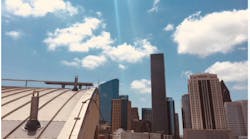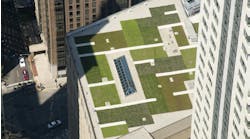Green roofs are a challenging proposition for existing buildings because not every structure can handle the extra weight or maintenance. But buildings that can bear the load tend to perform better, and they also showcase the owner’s commitment to sustainable building operation. Building owners have many reasons to invest in green roofs, but these five green roof benefits are cited most often.
1. Local Requirements
Some areas, such as Washington, require at least part of the roof to be vegetated, explains Matt Biesecker, senior designer for LandDesign. The requirements are typically based on environmental impacts, such as energy efficiency.
In the capital’s case, the requirements are intended to mitigate stormwater discharge. Green space is measured by a metric called the Green Area Ratio (GAR), which assigns points to various landscape elements that are weighted according to their environmental value. Intensive vegetated roofs with more than 8 inches of growing media are weighted more heavily than extensive roofs with 2-8 inches, for example.
[Related: Denver Water Sets an Example for Water Conservation]
All new buildings must achieve at least the minimum GAR value allowed in their zoning district. Existing buildings with additions or interior renovations must comply if the construction cost of the project is more than the assessed value of the improvements.
2. Efficient Building Operation
Green roofs contribute to lowering operating costs in three ways:
- Functioning as an extra thick layer of insulation, which then lowers the building’s heating and cooling requirements
- Absorbing stormwater and minimizing runoff
- Mitigating the urban heat island effect
“Green roofs generally benefit the lifespan of the roofing materials underneath as well. By covering a roof with a green roof, you’re protecting it,” says Andrew Franz, founder of Andrew Franz Architect. “The membrane is not exposed to sun, UV rays, hailstorms or other deterioration. You’re basically putting another membrane and soil above it, so it really does extend the life of most roofs as long as everything is installed correctly.”
(Photo: The paved walkway on the roof of LandDesign's Washington, DC, headquaraters creates an easily accessible path for the facilities team to maintain the green roof. Credit: LandDesign)
Soil containment is the key to maintaining the roof’s contribution to whole-building efficiency. The green roof needs properly installed drainage mats and filter fabrics below the soil. This ensures that the water will percolate down and drain gradually rather than flooding down all at once, taking plants and leaves with it and clogging your drains.
BUILDINGS Podcast
Carlisle Roofing Series #2: Roof Gardens
Vegetated roofs aren’t just beautiful—they’re valuable tools for managing stormwater, reducing the urban heat island effect, and providing more usable space for building occupants.
In the second installation of the Carlisle Roofing Series, Janelle Penny chats with Chris Kann, roof garden product manager for Carlisle, about best practices for green roof projects. Listen now >>
“A proper green roof operates like a colander. The water runs through, but the pasta stays in the colander,” Franz says. “The goal is to have that type of filter above the real roof surface to allow drainage and make sure there’s no clogging.”
3. Comfort
The roof’s contribution to energy efficiency also keeps people inside the building more comfortable, Franz says. The building will require less heating or cooling, which makes it easier to keep spaces comfortable.
You can also avoid the quandary of choosing between turning up the heat or air conditioning to compensate for outside temperatures (which can make people who have acclimated to the indoor temperature uncomfortable) or turning down the heat or air conditioning and risking your building not being able to keep up with the temperature changes outside.
(Photo: This mixed-use development on Hudson Street in New York City adds an urban garden to an expanded living area. Credit: Andrew Franz Architect)
4. Green Certification Credits
Green roofs can contribute to credits for green building certifications. You may be able to count your green roof toward several different credits, depending on the certification you pursue.
LEED, for example, might allow you to count a green roof toward credits for mitigating the heat island effect, stormwater design, maximizing open space, water-efficient landscaping, and even protecting or restoring habitat if you use plants that are native or adapted to your area and provide habitat.
5. Tenant Amenities
Many building owners opt for green roofs to create a lush tenant amenity. Some green roofs become accessible rooftop outdoor space that people can visit, while others simply create a better view on lower roofs that building occupants can see when they look out the window.
“There are green roofs that are meant to be inhabited and green roofs that are just there to insulate and manage stormwater runoff,” says Franz. “It’s much more challenging to create usable, walkable roofs and still have the proper buildup of soil and drainage. Grass is abused in a park or backyard, and on a green roof, all the more so.”
Franz recommends restricting foot traffic to pavers or a wood deck on a roof that’s meant to be usable. This is especially advisable if you choose sedums or other plants that can’t handle constant impact. A roof that can function as a lawn requires a significantly thicker layer of growing media, which adds quite a bit of weight to your building.
[On topic: 5 Things to Consider When Turning Your Rooftop into Usable Space]
Precautions and Deal Breakers
There are a few hurdles that can make or break your green roof project if you’re not careful. The prospect of adding extra weight to an existing roof has sidelined more than a few green roof retrofits. Green roofs can weigh thousands of pounds and are even heavier when they’re wet, so a structure that can’t support the load isn’t a candidate for a green roof.
“You also have to get people up to the roof to maintain these vegetated areas,” Biesecker adds. “You have to work around existing mechanical equipment and make sure whatever you’re designing isn’t going to conflict with maintaining the facade on the existing building.”
(Photo: This Tribeca loft features a courtyard that leads to a planted roof atop the six-story multifamily building. The roof features bluestone pavers and low-maintenance plants that are native to the area. Credit: Andrew Franz Architect)
These factors also restrict plant choice. Sedums are relatively lightweight, but a tree with a large root ball will be quite heavy, Biesecker says. “Another consideration is soil depth,” he adds. “When you’re on the ground, you have relatively unlimited space to go down into the soil, but on the roof you don’t have that benefit. You may be limited to only a few inches of distance between the finished floor elevation of the building and the top of the slab where the waterproofing is.”
Green roofs require special care before and after installation, but a thoughtfully planned project and regular maintenance will ensure that your green roof performs like it should for years to come. Invest time and attention into specifying the right green roof for your building and reap the rewards.
Two handpicked articles to read next:



